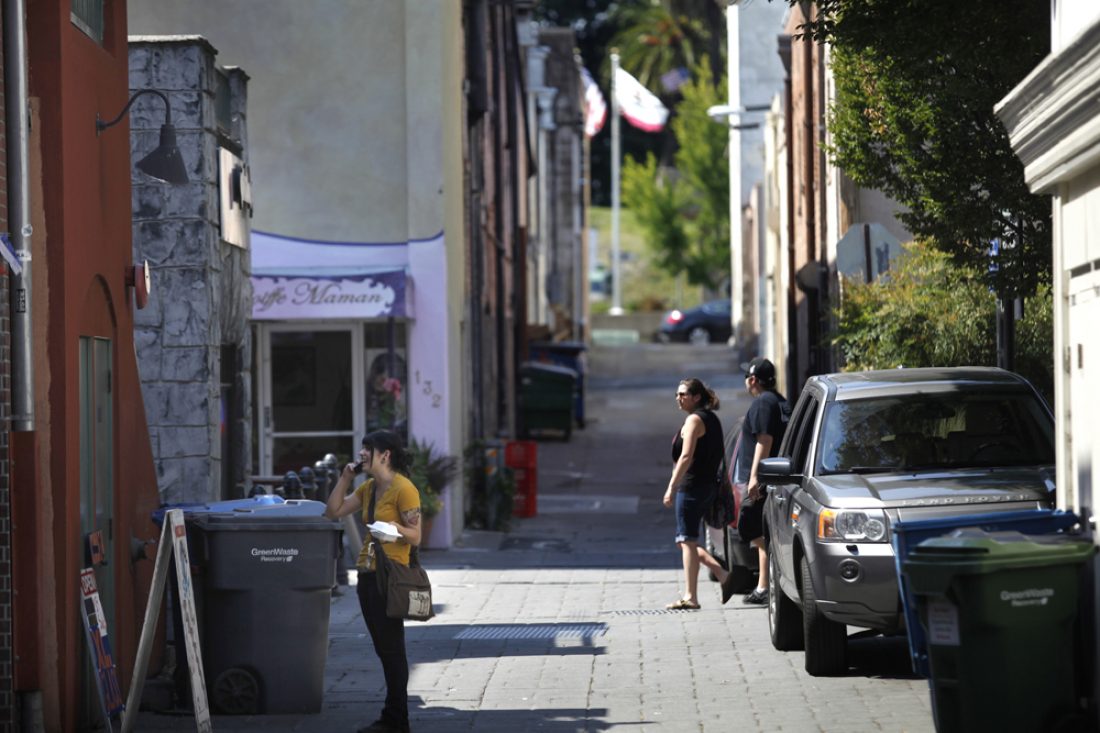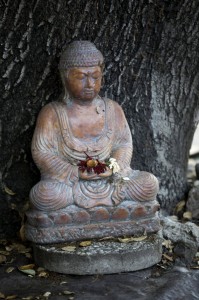By KATIE WATTS / Petaluma Towns Correspondent
Today’s Petaluma trivia question: how many alleys are in Petaluma?
We came up with seven: three residential, four downtown. Created to give rear access to homes and businesses, alleys are less common on the west coast than other areas of the country and seem to have gone out of city planning fashion by the 1950s.
Walking them offers a different perspective: not only the sense of traveling back to a simpler time. It’s being a kid again, finding a secret place. Ambling along them early on a weekend, there’s a sense of discovery. Oh, you know you’re not the first person to hear your shoes crunch on the gravel, but you feel you are. Like riding a train, alley walking can give a new angle to an area you thought you knew.
So lace up those virtual tennies for a tour. Later, if you want, you can discover them in person.
We’ll start on the Old East Side, walking between Wilson and Edith streets, from Jefferson to East D. Mourning doves coo, mockingbirds imitate frogs and the 101 is only a faint hum. It feels as if we’re on a country ramble. Trees are thick and shady in places.
This is a well-used alley, with back entrances, garages and parking areas, granny units and above-garage residences, many painted a cheerful yellow. And in early summer, the air is fragrant with star jasmine.
Our second alley has a similar country feel. It runs east from Fair to Baker Street, between English and Bassett. This alley is tree-shaded, including volunteer plum trees, and almost completely lined with fences, barns and sheds. One fence is patterned with cut-out holes; another has a Rube Goldberg-ish project tied to it. A royal purple clematis vine clambers over another. There’s a smell of hot, old wood – like Grandma’s attic on a warm summer afternoon. And, if you emerge from the alley onto Baker Street at the right time, you can purchase lemonade from an enterprising young lady.
The third alley is opposite the Petaluma High School tennis courts, entering on English Street next to the old Campfire Girls hut, designed by local architect Brainerd Jones and now a private residence.
This alley seems to have the most personality. There’s a vigorous curly willow and redwood trees, offering greenery and shade, followed by a carefully laid-out garden along a fence. Old-fashioned single hollyhocks, bright blue lobelia, mums, a small rose and orange pot marigolds bob cheerily in the breeze. There is a friendly black and white cutout of a cow, some plates set in concrete and solar lighting.
Next to the garden is a cut-out shortcut for a pet, including a saucer of water and a stump step for easy access – if you’re four-legged and furry. And opposite the garden is a cat-feeding station.
A little further, on the left, a serene Buddha sits below a live oak, holding a offering of chrysanthemums.
Of the dwellings facing the alley: one has a small garden of potted tomatoes and ferns, roses and geraniums. Further down, a barn-like shed, or shed-like barn, is draped with orange nasturtiums.
Look up to spot the most unexpected thing, the dodecahedron – a 12-sided glass tower addition to one of the houses on Broadway.
Pepper School Alley is named for Petaluma’s first kindergarten, begun in 1894 by nurseryman William Howard Pepper. The school, now on F Street, sat originally at the southwest corner of Washington and Liberty streets. It runs from Washington to Oak Street between Keokuk and Liberty.
Although longer, there’s not much to savor on Pepper School Alley: highlights were a purple and green gate leading to a pleasantly bubbling fountain; the area fragrant with star jasmine and roses and shaded by a magnolia and a tropical section of jasmine, palms, oleander and a lipstick vine.
There’s little to see along Hill Opera Alley either. The most interesting part is its historic name. The alley, which originally began at Washington Street and ended at Prospect, is named for what we know today as the Phoenix Theater. Built in 1904, the Hill Opera House was a legitimate theater. When talking pictures came in, it had a long run as the California Theater. To climb the alley now, walkers can cut through the Westamerica Bank parking lot.
American Alley, is named for the American Hotel, demolished in 1996 (now Putnam Plaza). Its most distinctive feature is the WPA-style mural on the back of Copperfield’s Books, painted in 1994 by Fernando Nugent and Charlie Roetter when the building was still home to Mattei Bros. clothing store.
Telephone Alley, between Western to Prospect, is divided by Washington Street. The downtown half is almost entirely backs of businesses and the western end of the Golden Concourse: the pedestrian walkway from the parking garage to the Boulevard. Across from the parking garage is an ivy-covered back yard with a Southern feel to it and, at the Washington Street end, on the back of the Social Club, one can read an ad for former tenants: Nielsen Furniture: Drapery, Floor Covering and Used Furn. Dept.
For the second half, we walked down from Prospect, facing Washington. Once again, it felt like green countryside. It was hard to believe we were a block from downtown. Pause at the top to admire the corner cottage’s clinker brick chimney, a look popular during the Arts and Crafts period.
Further down, two large palm trees and a fence-topped concrete wall are beginning to duel. Our money is on the trees. Then up looms the four-story Hotel Petaluma on the east, the red brick home of Mike’s Glass on the west. Cars whiz by, our rural moment vanishes and we reluctantly return to 2013.
—————-
IF YOU WALK:
Residential alleys
Old East Side: Runs from East D Street to Jefferson Street, paralleling Wilson and Edith streets.
West Side: Runs from Fair Street to Baker Street, paralleling English and Bassett streets; Runs from English Street to Dana Street: paralleling Sheldon and Broadway streets.
Downtown alleys
East to West: American Alley, Telephone Alley, Hill Opera Alley, Pepper School Alley, all off Washington Street.
Most of the alleys are unpaved, so wear comfortable walking shoes. And remember: the alleys are public, but the yards edging them are private property.


